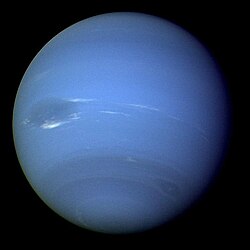Translations:AY Honors/Stars/Planet characteristics/10/en
Neptune
Neptune is the outermost gas giant in our solar system. It orbits the Sun once every 165 years. It is the fourth largest planet by diameter and the third largest by mass; Neptune is more massive than its near twin Uranus as its stronger gravitational field has compressed it to a higher density. Neptune's atmosphere is primarily composed of hydrogen and helium, with traces of methane that account for the planet's blue appearance. Neptune also has the strongest winds of any planet in the solar system, with estimates as high as 1550 MPH (2,500 km/h). Discovered on September 23, 1846, Neptune is notable for being the only planet discovered based on mathematical prediction rather than regular observations. Perturbations in the orbit of Uranus led astronomers to deduce Neptune's existence. One difference between Neptune and Uranus is the level of meteorological activity. Uranus is visually quite bland, while Neptune's high winds come with notable weather phenomena. The Great Dark Spot, a cyclonic storm system the size of Asia, was captured by Voyager 2 in the 1989 flyby. The storm resembled the Great Red Spot of Jupiter, but was shown to have disappeared in June 1994. However, a newer image of the planet taken by the Hubble Space Telescope on November 2, 1994, revealed that a smaller storm similar to its predecessor had formed over Neptune’s Northern Hemisphere. Unique among the gas giants is the presence of high clouds casting shadows on the opaque cloud deck below.

